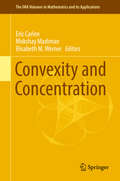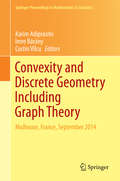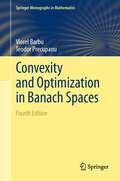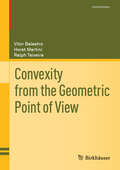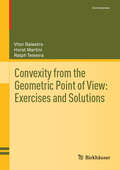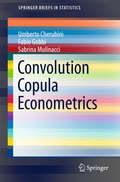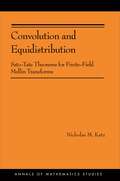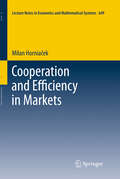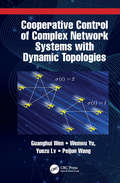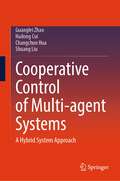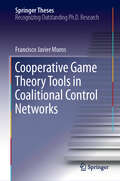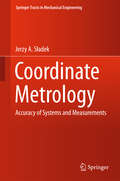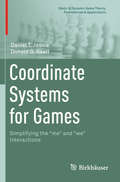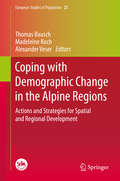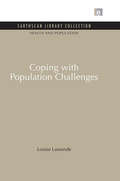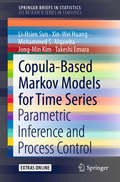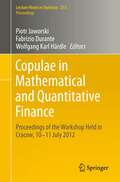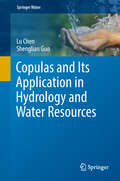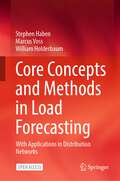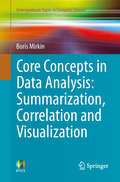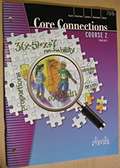- Table View
- List View
Convexity and Concentration (The IMA Volumes in Mathematics and its Applications #161)
by Eric Carlen Mokshay Madiman Elisabeth M. WernerThis volume presents some of the research topics discussed at the 2014-2015 Annual Thematic Program Discrete Structures: Analysis and Applications at the Institute of Mathematics and its Applications during the Spring 2015 where geometric analysis, convex geometry and concentration phenomena were the focus. Leading experts have written surveys of research problems, making state of the art results more conveniently and widely available. The volume is organized into two parts. Part I contains those contributions that focus primarily on problems motivated by probability theory, while Part II contains those contributions that focus primarily on problems motivated by convex geometry and geometric analysis. This book will be of use to those who research convex geometry, geometric analysis and probability directly or apply such methods in other fields.
Convexity and Discrete Geometry Including Graph Theory: Mulhouse, France, September 2014 (Springer Proceedings in Mathematics & Statistics #148)
by Karim Adiprasito Imre Bárány Costin VilcuThis volume presents easy-to-understand yet surprising properties obtained using topological, geometric and graph theoretic tools in the areas covered by the Geometry Conference that took place in Mulhouse, France from September 7-11, 2014 in honour of Tudor Zamfirescu on the occasion of his 70th anniversary. The contributions address subjects in convexity and discrete geometry, in distance geometry or with geometrical flavor in combinatorics, graph theory or non-linear analysis. Written by top experts, these papers highlight the close connections between these fields, as well as ties to other domains of geometry and their reciprocal influence. They offer an overview on recent developments in geometry and its border with discrete mathematics, and provide answers to several open questions. The volume addresses a large audience in mathematics, including researchers and graduate students interested in geometry and geometrical problems.
Convexity and Optimization in Banach Spaces (Springer Monographs in Mathematics)
by Viorel Barbu Teodor PrecupanuAn updated and revised edition of the 1986 title Convexity and Optimization in Banach Spaces, this book provides a self-contained presentation of basic results of the theory of convex sets and functions in infinite-dimensional spaces. The main emphasis is on applications to convex optimization and convex optimal control problems in Banach spaces. A distinctive feature is a strong emphasis on the connection between theory and application. This edition has been updated to include new results pertaining to advanced concepts of subdifferential for convex functions and new duality results in convex programming. The last chapter, concerned with convex control problems, has been rewritten and completed with new research concerning boundary control systems, the dynamic programming equations in optimal control theory and periodic optimal control problems. Finally, the structure of the book has been modified to highlight the most recent progression in the field including fundamental results on the theory of infinite-dimensional convex analysis and includes helpful bibliographical notes at the end of each chapter.
Convexity from the Geometric Point of View (Cornerstones)
by Horst Martini Vitor Balestro Ralph TeixeiraThis text gives a comprehensive introduction to the “common core” of convex geometry. Basic concepts and tools which are present in all branches of that field are presented with a highly didactic approach. Mainly directed to graduate and advanced undergraduates, the book is self-contained in such a way that it can be read by anyone who has standard undergraduate knowledge of analysis and of linear algebra. Additionally, it can be used as a single reference for a complete introduction to convex geometry, and the content coverage is sufficiently broad that the reader may gain a glimpse of the entire breadth of the field and various subfields. The book is suitable as a primary text for courses in convex geometry and also in discrete geometry (including polytopes). It is also appropriate for survey type courses in Banach space theory, convex analysis, differential geometry, and applications of measure theory. Solutions to all exercises are available to instructors who adopt the text for coursework.Most chapters use the same structure with the first part presenting theory and the next containing a healthy range of exercises. Some of the exercises may even be considered as short introductions to ideas which are not covered in the theory portion. Each chapter has a notes section offering a rich narrative to accompany the theory, illuminating the development of ideas, and providing overviews to the literature concerning the covered topics. In most cases, these notes bring the reader to the research front. The text includes many figures that illustrate concepts and some parts of the proofs, enabling the reader to have a better understanding of the geometric meaning of the ideas. An appendix containing basic (and geometric) measure theory collects useful information for convex geometers.
Convexity from the Geometric Point of View: Exercises and Solutions (Cornerstones)
by Horst Martini Vitor Balestro Ralph TeixeiraThis book provides the solutions to all 347 exercises contained in the text Convexity from the Geometric Point of View, published in the same Cornerstones series. All these exercises are restated and numbered analogously to those in the original text. The corresponding solutions follow each exercise. Besides the discussion of all solutions, some additional facts about the main text are sprinkled throughout. Sections of further reading are posted to the ends of each chapter supplying the reader with background literature to selected notions and tools that play a role in the exercises and/or solutions to the chapter. The original text gives a comprehensive introduction to the “common core” of convex geometry and is suitable as a primary text for courses in convex geometry and in discrete geometry (including polytopes). Additionally, it can be used as a single reference for a complete introduction to convex geometry. The content coverage is sufficiently broad that the reader may gain a glimpse of the entire breadth of the field, various subfields, and interesting connections to neighboring disciplines. Mainly directed to graduate and advanced undergraduates, the original text is self-contained in such a way that it can be read by anyone who has standard undergraduate knowledge of analysis and of linear algebra. The same is true for this book of solutions.
Convexity in Newton's Method (Frontiers in Mathematics)
by Miguel Ángel Hernández Verón José Antonio Ezquerro FernándezThis monograph examines a variety of iterative methods in Banach spaces with a focus on those obtained from the Newton method. Together with the authors&’ previous two volumes on the topic of the Newton method in Banach spaces, this third volume significantly extends Kantorovich's initial theory. It accomplishes this by emphasizing the influence of the convexity of the function involved, showing how improved iterative methods can be obtained that build upon those introduced in the previous two volumes. Each chapter presents theoretical results and illustrates them with applications to nonlinear equations, including scalar equations, integral equations, boundary value problems, and more. Convexity in Newton's Method will appeal to researchers interested in the theory of the Newton method as well as other iterative methods in Banach spaces.
Convexity: An Analytic Viewpoint
by Barry SimonConvexity is important in theoretical aspects of mathematics and also for economists and physicists. In this monograph the author provides a comprehensive insight into convex sets and functions including the infinite-dimensional case and emphasizing the analytic point of view. Chapter one introduces the reader to the basic definitions and ideas that play central roles throughout the book. The rest of the book is divided into four parts: convexity and topology on infinite-dimensional spaces; Loewner's theorem; extreme points of convex sets and related issues, including the Krein–Milman theorem and Choquet theory; and a discussion of convexity and inequalities. The connections between disparate topics are clearly explained, giving the reader a thorough understanding of how convexity is useful as an analytic tool. A final chapter overviews the subject's history and explores further some of the themes mentioned earlier. This is an excellent resource for anyone interested in this central topic.
Convolution Copula Econometrics (SpringerBriefs in Statistics)
by Umberto Cherubini Sabrina Mulinacci Fabio GobbiThis book presents a novel approach to time series econometrics, which studies the behavior of nonlinear stochastic processes. This approach allows for an arbitrary dependence structure in the increments and provides a generalization with respect to the standard linear independent increments assumption of classical time series models. The book offers a solution to the problem of a general semiparametric approach, which is given by a concept called C-convolution (convolution of dependent variables), and the corresponding theory of convolution-based copulas. Intended for econometrics and statistics scholars with a special interest in time series analysis and copula functions (or other nonparametric approaches), the book is also useful for doctoral students with a basic knowledge of copula functions wanting to learn about the latest research developments in the field.
Convolution and Equidistribution: Sato-Tate Theorems for Finite-Field Mellin Transforms (AM-180) (Annals of Mathematics Studies #180)
by Nicholas M. KatzConvolution and Equidistribution explores an important aspect of number theory--the theory of exponential sums over finite fields and their Mellin transforms--from a new, categorical point of view. The book presents fundamentally important results and a plethora of examples, opening up new directions in the subject. The finite-field Mellin transform (of a function on the multiplicative group of a finite field) is defined by summing that function against variable multiplicative characters. The basic question considered in the book is how the values of the Mellin transform are distributed (in a probabilistic sense), in cases where the input function is suitably algebro-geometric. This question is answered by the book's main theorem, using a mixture of geometric, categorical, and group-theoretic methods. By providing a new framework for studying Mellin transforms over finite fields, this book opens up a new way for researchers to further explore the subject.
Cooperation and Efficiency in Markets (Lecture Notes in Economics and Mathematical Systems #649)
by Milan HorniačekThe book deals with collusion between firms on both sides of a market that is immune to deviations by coalitions. We study this issue using an infinitely countably repeated game with discounting of future single period payoffs. A strict strong perfect equilibrium is the main solution concept that we apply. It requires that no coalition of players in no subgame can weakly Pareto improve the vector of continuation average discounted payoffs of its members by a deviation. If the sum of firms' average discounted profits is maximized along the equilibrium path then the equilibrium output of each type of good is produced with the lowest possible costs. If, in addition, all buyers are retailers (i.e., they resell the goods purchased in the analyzed market in a retail market) then the equilibrium vector of the quantities sold in the retail market is sold with the lowest possible selling costs. We specify sufficient conditions under which collusion increases consumer welfare.
Cooperative Control of Complex Network Systems with Dynamic Topologies
by Wenwu Yu Guanghui Wen Yuezu Lv Peijun WangFar from being separate entities, many social and engineering systems can be considered as complex network systems (CNSs) associated with closely linked interactions with neighbouring entities such as the Internet and power grids. Roughly speaking, a CNS refers to a networking system consisting of lots of interactional individuals, exhibiting fascinating collective behaviour that cannot always be anticipated from the inherent properties of the individuals themselves. As one of the most fundamental examples of cooperative behaviour, consensus within CNSs (or the synchronization of complex networks) has gained considerable attention from various fields of research, including systems science, control theory and electrical engineering. This book mainly studies consensus of CNSs with dynamics topologies - unlike most existing books that have focused on consensus control and analysis for CNSs under a fixed topology. As most practical networks have limited communication ability, switching graphs can be used to characterize real-world communication topologies, leading to a wider range of practical applications. This book provides some novel multiple Lyapunov functions (MLFs), good candidates for analysing the consensus of CNSs with directed switching topologies, while each chapter provides detailed theoretical analyses according to the stability theory of switched systems. Moreover, numerical simulations are provided to validate the theoretical results. Both professional researchers and laypeople will benefit from this book.
Cooperative Control of Multi-agent Systems: A Hybrid System Approach
by Changchun Hua Shuang Liu Guanglei Zhao Hailong CuiThis book focuses on stability analysis and control design approaches for multi-agent systems under network-induced constraints. A hybrid system approach is introduced to address the cooperative control problem of networked multi-agent systems, and several important topics such as asynchronous sampled data cooperative control, hybrid event-triggered cooperative control, and reset-based cooperative control are studied under the hybrid system framework. The special feature of this book is that a hybrid systems approach is proposed for the cooperative control of multi-agent systems, which is beneficial for relaxing the conservativeness of stability analysis and network parameter computation. Interested readers can learn a novel approach to cooperative control of multi-agent systems, and this book can benefit researchers, engineers, and graduate students in the fields of multi-robot cooperation, unmanned aerial vehicle formation, control engineering, etc.
Cooperative Game Theory Tools in Coalitional Control Networks (Springer Theses)
by Francisco Javier MurosThis book analyzes coalitional control schemes by incorporating concepts of cooperative game theory into a distributed control framework. It considers a networked architecture where the nodes are the agents and the edges are their communication links and either the agents or the links are established as the players of cooperative games related to the cost function of the coalitional schemes. The book discusses various cooperative game theory tools that are used to measure/analyze the players’ features, impose constraints on them, provide alternative methods of game computation, detect critical players inside the control scheme, and perform system partitioning of large-scale systems, such as the Barcelona drinking water network, which is described in a case study.
Coordinate Metrology: Accuracy of Systems and Measurements (Springer Tracts in Mechanical Engineering)
by Jerzy A. SładekThis book focuses on effective methods for assessing the accuracy of both coordinate measuring systems and coordinate measurements. It mainly reports on original research work conducted by Sladek's team at Cracow University of Technology's Laboratory of Coordinate Metrology. The book describes the implementation of different methods, including artificial neural networks, the Matrix Method, the Monte Carlo method and the virtual CMM (Coordinate Measuring Machine), and demonstrates how these methods can be effectively used in practice to gauge the accuracy of coordinate measurements. Moreover, the book includes an introduction to the theory of measurement uncertainty and to key techniques for assessing measurement accuracy. All methods and tools are presented in detail, using suitable mathematical formulations and illustrated with numerous examples. The book fills an important gap in the literature, providing readers with an advanced text on a topic that has been rapidly developing in recent years. The book is intended for master and PhD students, as well as for metrology engineers working at industrial and research laboratories. It not only provides them with a solid background for using existing coordinate metrology methods; it is also meant to inspire them to develop the state-of-the-art technologies that will play an important role in supporting quality growth and innovation in advanced manufacturing.
Coordinate Systems for Games: Simplifying the "me" and "we" Interactions (Static & Dynamic Game Theory: Foundations & Applications)
by Donald G. Saari Daniel T. JessieThis monograph develops a method of creating convenient coordinate systems for game theory that will allow readers to more easily understand, analyze, and create games at various levels of complexity. By identifying the unique characterization of games that separates the individual’s strategic interests from the group’s collective behavior, the authors construct a single analytical methodology that readers will be able to apply to a wide variety of games. With its emphasis on practicality and approachability, readers will find this book an invaluable tool, and a viable alternative to the ad hoc analytical approach that has become customary for researchers utilizing game theory.The introductory chapters serve two important purposes: they review several games of fundamental importance, and also introduce a dynamic that is inherent in games, but has gone unexplored until now. After this has been established, readers will advance from simple 2 x 2 games to games with more player strategies and dynamics. For interested readers, a rigorous treatment of the underlying mathematics is conveniently gathered at the end of the book. Additional topics of interest, such as extensive form and coalitional games, are presented to help readers visualize more complex settings that will be vital in aiding the understanding of advanced topics, such as coalition-free Nash points, multi-player repeated games, and more.Coordinate Systems for Games is ideal for a wide variety of researchers interested in game theory, including social scientists, economists, mathematicians, computer scientists, and more. The authors' approachable style also makes this accessible to an audience at any scale of experience, from beginning non-specialists to more practiced researchers.
Coping with Demographic Change in the Alpine Regions: Actions and Strategies for Spatial and Regional Development (European Studies of Population #23)
by Thomas Bausch Madeleine Koch Alexander VeserEurope's population is ageing and decreasing. Demographic change is making not only regional and territorial adaptation necessary, but also new region-specific spatial planning and regional development. This publication focusses on demographic change and its implications for the economy and social systems in the Alpine areas, which differ widely from their surrounding metropolitan areas. It provides a specific regional in-depth study in order to help establish suitable adaptation and development programs. It covers various aspects including demographic analysis, onsite participatory strategies and implementation processes, as well as generalized adaptation strategies. Reports on pilot actions in various regions across the Alps demonstrate how demographic change can be approached from a practitioner's perspective. The volume is based on the results of the project DEMOCHANGE, which was co-funded by the European Regional Development Fund in the frame of the European Territorial Cooperation "Alpine Space" program.
Coping with Population Challenges (Health And Population Set Ser.)
by Louise LassondeDespite rapidly decreasing rates of population growth caused by reduced fertility in the majority of world regions, demographers are predicting that the world's population will still double by the year 2050. The question is therefore no longer the traditional one of whether the planet can support so many people, but how to provide a sustainable future for ten billion individuals. Quantitative problems have become ethical ones. Coping with Population Challenges addresses these issues in the context of international debate and agreements since the first World Population Plan of Action in 1974 to the 20-year Programme of Action adopted at the International Conference on Population and Development in Cairo in 1994. The author describes how the Programme of Action focuses on women's issues, reproductive choice and the notion of the individual. However, she identifies a number of important but neglected areas of the debate that the Programme failed to address and brings to light some of the inconsistencies that need to be resolved if the Programme is to be implemented. The author also looks at the underlying ethical dimension of all choices relating to the population issue and suggests measures and machinery for giving effect to states' commitments, including reformulating problems and defining the appropriate economic framework for solutions. The book is an excellent introduction for the non-specialist to a very topical debate, and a useful reference for researchers.
Copula Additive Distributional Regression Using R (Chapman & Hall/CRC The R Series)
by Giampiero Marra Rosalba RadiceCopula additive distributional regression enables the joint modeling of multiple outcomes, an essential aspect of many real-world research problems. This book provides an accessible overview of this modeling approach, with a particular focus on its implementation in the GJRM R package, developed by the authors. The emphasis is on bivariate responses with empirical illustrations drawn from diverse fields such as health and medicine, epidemiology, economics and social sciences.Key Features: Provides a comprehensive overview of joint regression modeling for multiple outcomes, with a focus on bivariate responses Offers a practical approach with real-world examples from various fields Demonstrates the implementation of all the discussed models using the GJRM package in R Includes supplementary resources such as data accessible through the GJRM.data package in R and additional code available on the authors' webpages This book is designed for graduate students, researchers, practitioners and analysts who are interested in using copula additive distributional regression for the joint modeling of bivariate outcomes. The methodology is accessible to readers with a basic understanding of core statistics and probability, regression, copula modeling and R.
Copula-Based Markov Models for Time Series: Parametric Inference and Process Control (SpringerBriefs in Statistics)
by Takeshi Emura Li-Hsien Sun Xin-Wei Huang Mohammed S. Alqawba Jong-Min KimThis book provides statistical methodologies for time series data, focusing on copula-based Markov chain models for serially correlated time series. It also includes data examples from economics, engineering, finance, sport and other disciplines to illustrate the methods presented. An accessible textbook for students in the fields of economics, management, mathematics, statistics, and related fields wanting to gain insights into the statistical analysis of time series data using copulas, the book also features stand-alone chapters to appeal to researchers. As the subtitle suggests, the book highlights parametric models based on normal distribution, t-distribution, normal mixture distribution, Poisson distribution, and others. Presenting likelihood-based methods as the main statistical tools for fitting the models, the book details the development of computing techniques to find the maximum likelihood estimator. It also addresses statistical process control, as well as Bayesian and regression methods. Lastly, to help readers analyze their data, it provides computer codes (R codes) for most of the statistical methods.
Copulae in Mathematical and Quantitative Finance: Proceedings of the Workshop Held in Cracow, 10-11 July 2012 (Lecture Notes in Statistics #213)
by Fabrizio Durante Wolfgang Karl Härdle Piotr JaworskiCopulas are mathematical objects that fully capture the dependence structure among random variables and hence offer great flexibility in building multivariate stochastic models. Since their introduction in the early 1950s, copulas have gained considerable popularity in several fields of applied mathematics, especially finance and insurance. Today, copulas represent a well-recognized tool for market and credit models, aggregation of risks, and portfolio selection. Historically, the Gaussian copula model has been one of the most common models in credit risk. However, the recent financial crisis has underlined its limitations and drawbacks. In fact, despite their simplicity, Gaussian copula models severely underestimate the risk of the occurrence of joint extreme events. Recent theoretical investigations have put new tools for detecting and estimating dependence and risk (like tail dependence, time-varying models, etc) in the spotlight. All such investigations need to be further developed and promoted, a goal this book pursues. The book includes surveys that provide an up-to-date account of essential aspects of copula models in quantitative finance, as well as the extended versions of talks selected from papers presented at the workshop in Cracow.
Copulas and Its Application in Hydrology and Water Resources (Springer Water)
by Lu Chen Shenglian GuoThis book presents an overview of copula theory and its application in hydrology, and provides valuable insights, useful methods and practical applications for multivariate hydrological analysis using copulas. In addition, it extends the traditional bivariate model to trivariate or multivariate models. The specific applications covered include the study of flood frequency analysis, drought frequency analysis, dependence analysis, flood coincidence risk analysis and statistical simulation using copulas. The book offers a valuable guide for researchers, scientists and engineers working in hydrology and water resources, and will also benefit graduate or doctoral students with a basic grasp of copula functions who want to learn about the latest research developments in the field.
Core Concepts and Methods in Load Forecasting: With Applications in Distribution Networks
by William Holderbaum Stephen Haben Marcus VossThis comprehensive open access book enables readers to discover the essential techniques for load forecasting in electricity networks, particularly for active distribution networks.From statistical methods to deep learning and probabilistic approaches, the book covers a wide range of techniques and includes real-world applications and a worked examples using actual electricity data (including an example implemented through shared code). Advanced topics for further research are also included, as well as a detailed appendix on where to find data and additional reading. As the smart grid and low carbon economy continue to evolve, the proper development of forecasting methods is vital. This book is a must-read for students, industry professionals, and anyone interested in forecasting for smart control applications, demand-side response, energy markets, and renewable utilization.
Core Concepts in Data Analysis: Summarization, Correlation And Visualization (Undergraduate Topics in Computer Science)
by Boris MirkinCore Concepts in Data Analysis: Summarization, Correlation and Visualization provides in-depth descriptions of those data analysis approaches that either summarize data (principal component analysis and clustering, including hierarchical and network clustering) or correlate different aspects of data (decision trees, linear rules, neuron networks, and Bayes rule). Boris Mirkin takes an unconventional approach and introduces the concept of multivariate data summarization as a counterpart to conventional machine learning prediction schemes, utilizing techniques from statistics, data analysis, data mining, machine learning, computational intelligence, and information retrieval. Innovations following from his in-depth analysis of the models underlying summarization techniques are introduced, and applied to challenging issues such as the number of clusters, mixed scale data standardization, interpretation of the solutions, as well as relations between seemingly unrelated concepts: goodness-of-fit functions for classification trees and data standardization, spectral clustering and additive clustering, correlation and visualization of contingency data. The mathematical detail is encapsulated in the so-called "formulation" parts, whereas most material is delivered through "presentation" parts that explain the methods by applying them to small real-world data sets; concise "computation" parts inform of the algorithmic and coding issues. Four layers of active learning and self-study exercises are provided: worked examples, case studies, projects and questions.
Core Connections Course 2 Version 5
by Leslie Dietiker Evra Baldinger Michael Kassarjian Barbara ShreveCore Connections Course 2
Core Connections Integrated II
by Leslie DietikerCore Connections Integrated II Core Connections Integrated II is the second course in a five-year sequence of college preparatory mathematics courses that starts with Core Connections Integrated I and continues through Calculus Third Edition. It aims to formalize and extend the geometry that students have learned in previous courses. It does this by focusing on establishing triangle congruence criteria using rigid motions and formal constructions and building a formal understanding of similarity based on dilations and proportional reasoning. It also helps students develop the concepts of formal proof, explore the properties of two- and three-dimensional objects, work within the rectangular coordinate system to verify geometric relationships and prove basic theorems about circles. Students also use the language of set theory to compute and interpret probabilities for compound events. On a daily basis, students in Core Connections Integrated II use problem-solving strategies, questioning, investigating, analyzing critically, gathering and constructing evidence, and communicating rigorous arguments justifying their thinking. Under teacher guidance, students learn in collaboration with others while sharing information, expertise, and ideas.
